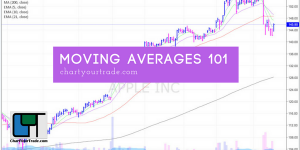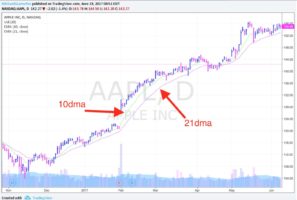 What is a Simple Moving Average?
What is a Simple Moving Average?
Investopedia.com defines a simple moving average (SMA) as:
“A simple, or arithmetic, moving average that is calculated by adding the closing price of the security for a number of time periods and then dividing this total by the number of time periods. Short-term averages respond quickly to changes in the price of the underlying, while long-term averages are slow to react.“
Moving averages can be defined in virtually any time frame. The two most common are the 50 and 200 day moving average (DMA) lines. These are also known as the 10-week and 40-week moving averages.
Most Common Moving Averages
 The 50 and 200 DMA lines simply look at the past 50 or 200 days and a line is drawn to illustrate the average close during that period.
The 50 and 200 DMA lines simply look at the past 50 or 200 days and a line is drawn to illustrate the average close during that period.
In a healthy uptrend, you want to see the both moving averages slope higher. The 50 DMA line should reside above the longer term 200 DMA.
When the 50 DMA turns lower, or slices below its longer term 200 DMA counterpart it is usually a sign of weakness. Some technical trading systems flash buy/sell signals when either moving average “crosses over” the other.
Other Moving Averages
 Several studies show that leading stocks tend to pull back and find support at their respective 10 and 21-day moving averages before resuming their prior trend. These are shorter term moving averages and tend to be more volatile in nature. However, they are still an important way to gauge the underlying health of a stock. They are even used by some investors as a healthy area to accumulate a position.
Several studies show that leading stocks tend to pull back and find support at their respective 10 and 21-day moving averages before resuming their prior trend. These are shorter term moving averages and tend to be more volatile in nature. However, they are still an important way to gauge the underlying health of a stock. They are even used by some investors as a healthy area to accumulate a position.
An important intermediate term moving average is the 150-day moving average (30-week). The 150 DMA is an important gauge that defines the intermediate term health of a stock (or market).
Price vs. Moving Averages
If the price of a stock or a market is trading above a moving average then the action is healthy. If the price is trading below an important moving average then the action is not as healthy. …Yes, it is THAT simple.
It is also healthy to see a stock move back to a moving average on light volume during an uptrend and then bounce off that moving average on higher volume. This is both natural and healthy. Most leading stocks and markets tend to do this as they move higher. Moving averages offer prudent investors a chance to accumulate a position as the underlying investment pulls back to a logical area of support.
Be careful! A technical sell signal will be triggered once an important moving average is broken especially if volume is heavy. This is an important warning sign most investors should look for.
Simple Rule of Thumb:
As a simple rule, only look to buy when the underlying price is above an important moving average and go short when the price is below an important moving average. This is the basic rule, but of course, like any rule, it is important to know when it is o.k. to break that rule!





